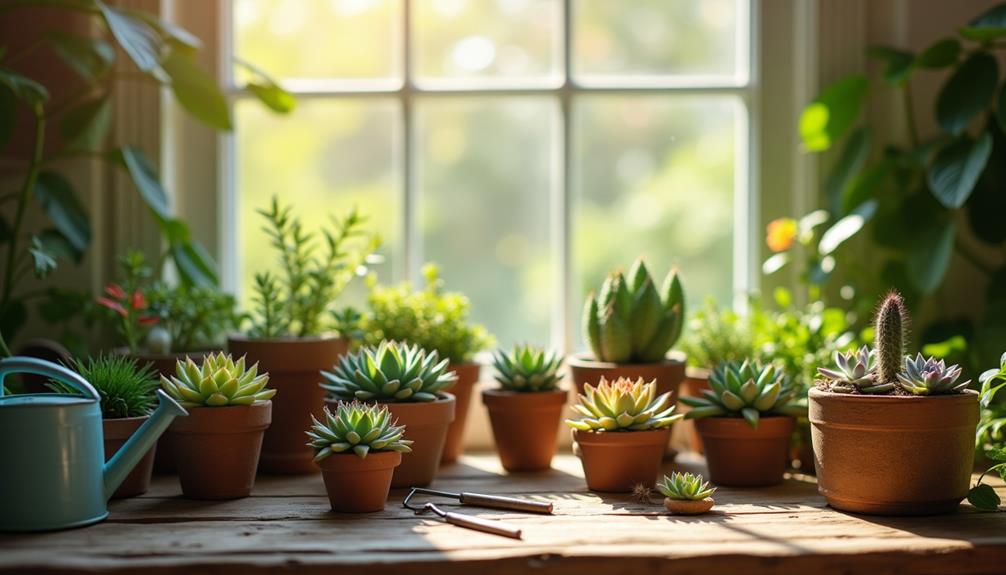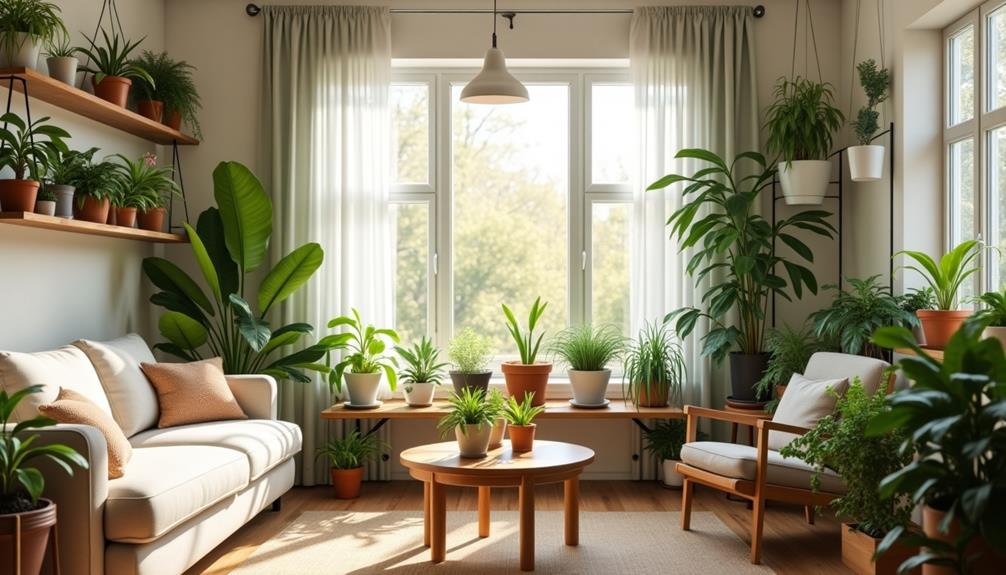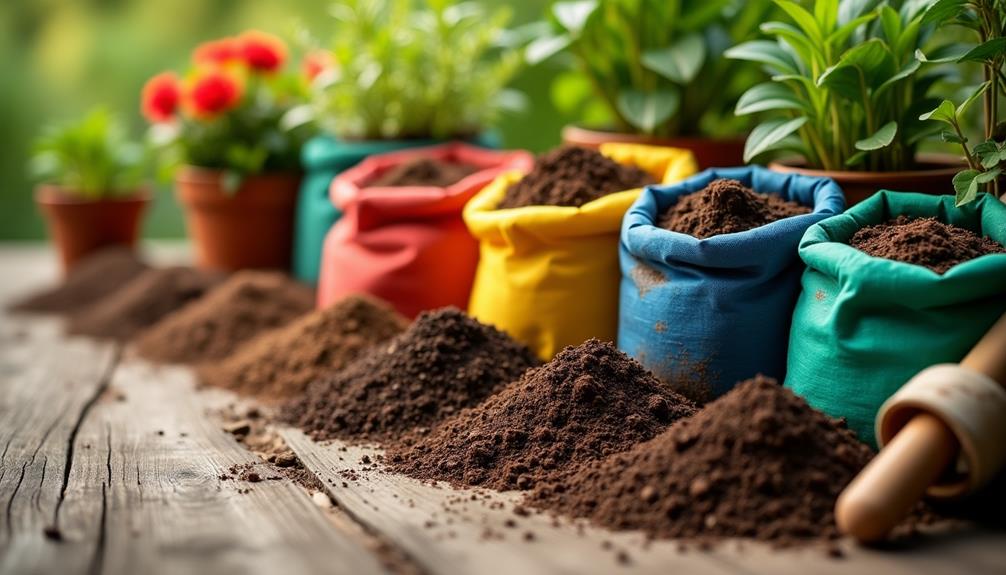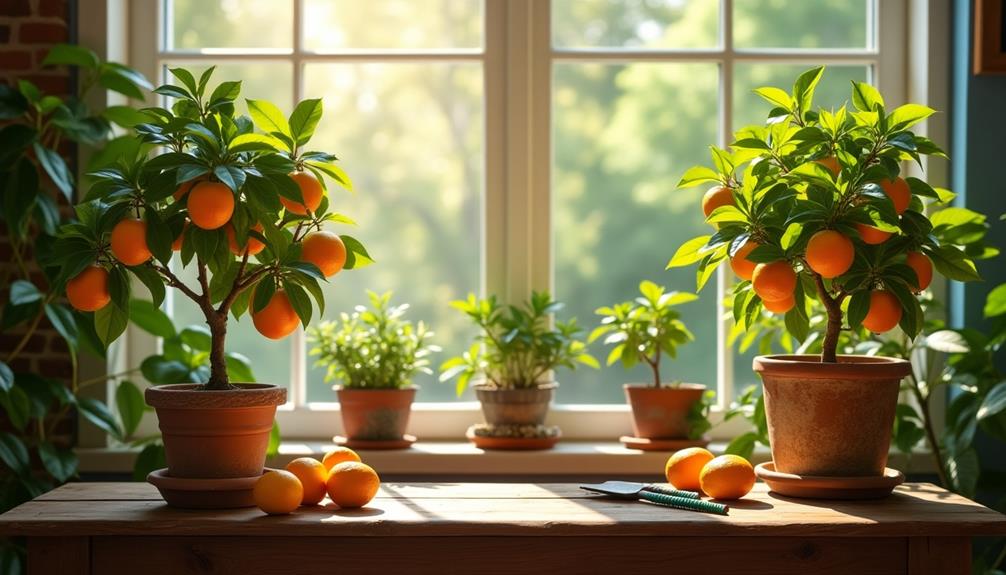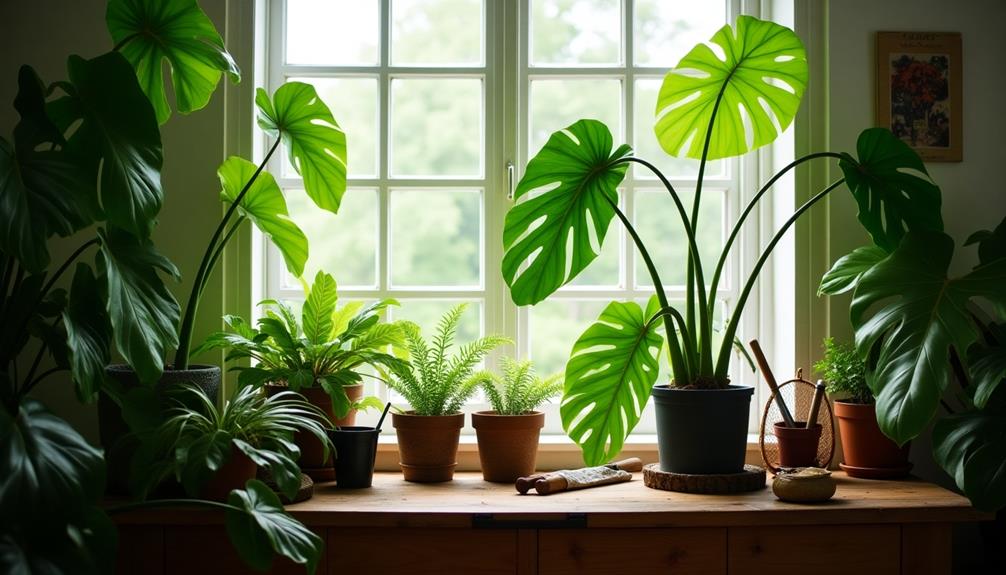If you're new to caring for succulents, you might be surprised at how simple it can be. Start by selecting the right types for your home, as not all succulents thrive in the same conditions. You'll also need to understand their light requirements and develop a proper watering routine to keep them healthy. The right soil and potting techniques are crucial, too. But what happens when pests or seasonal changes come into play? Let's explore how to ensure your succulents not only survive but truly flourish in your space.
Choosing the Right Succulents
When you're choosing the right succulents for your home, consider your space and lifestyle. You want to select succulent varieties that fit seamlessly into your environment. If you have a small apartment, opt for compact plants like Echeveria or Haworthia. These varieties thrive in limited spaces and add a touch of green without overwhelming your decor.
Think about your indoor placement, too. If you're planning to showcase them on a windowsill or in a bright room, you can go for larger varieties like Jade or Aloe Vera. However, if you have less light, consider hardier options like ZZ plants or Snake plants, which can tolerate lower light conditions.
Also, consider your maintenance preferences. Some succulent varieties require more attention and watering than others. If you're busy or a beginner, low-maintenance types like Sedum or Sempervivum are fantastic options.
Understanding Light Requirements
Selecting the right succulents also involves understanding their light requirements. Succulents thrive in bright, natural sunlight, but not all varieties need the same amount. When choosing a spot for your plants, consider how much natural light your space receives throughout the day.
If you're keeping your succulents indoors, aim for a south or west-facing window where they'll get the most exposure. However, if your indoor lighting isn't optimal, you might need to supplement with grow lights. These can mimic natural sunlight and ensure your plants get the energy they need to flourish.
Keep an eye on your succulents; if they start stretching or leaning toward the light, they might be craving more sun. Conversely, too much direct sunlight can scorch their leaves, so be mindful of their specific needs.
Understanding the balance between light and shade is crucial for healthy succulents. Rotate your plants occasionally to promote even growth and avoid uneven lighting.
With the right light conditions, your succulents will thrive and bring vibrant life to your home.
Proper Watering Techniques
Mastering proper watering techniques is essential for keeping your succulents healthy and vibrant. These plants thrive in dry conditions, so understanding how to balance water with humidity levels is crucial.
Start by checking the soil moisture before watering. Stick your finger about an inch into the soil; if it feels dry, it's time to water. On the flip side, if it's still damp, wait a few more days.
When you do water, make sure to soak the soil thoroughly, allowing excess water to drain out. This encourages deep root growth, which is vital for succulents. However, avoid letting your plants sit in standing water, as this can lead to root rot.
Your watering frequency will depend on the climate and season. In warmer months, you might need to water every week, while in cooler months, every two to three weeks could suffice.
Always consider the humidity levels in your home; higher humidity might require less frequent watering. By paying attention to these factors, you'll ensure your succulents remain healthy and thriving in their environment.
Selecting the Right Soil
Choosing the right soil is crucial for your succulents' health and growth. Succulents thrive in well-draining environments, so you'll want to choose a soil type that meets their specific needs.
Standard potting soil can retain too much moisture, leading to root rot, so it's best to avoid that. Instead, look for specialized cactus or succulent mixes available at garden centers. These blends typically contain a combination of organic materials and inorganic components like perlite or coarse sand, which enhance drainage essentials.
You can also create your own mix by combining regular potting soil with items like pumice or gravel to improve aeration and drainage. When selecting soil, ensure it has a gritty texture, which allows excess water to flow away from the roots.
A good rule of thumb is to aim for a soil mix that retains some moisture but dries out quickly between waterings. This balance is key to keeping your succulents healthy.
Potting and Repotting Basics
After ensuring your succulents have the right soil, it's time to focus on potting and repotting.
First, choose a pot with drainage holes to prevent water from accumulating at the bottom. When potting, gently remove your succulent from its current container, being careful not to damage the roots. If it's tightly bound, you might need to loosen the roots slightly.
Place a layer of fresh soil in the new pot, then position your succulent in the center and fill around it with more soil, making sure to leave some space at the top for watering.
As for repotting frequency, it's generally recommended to repot succulents every couple of years, or when they outgrow their current pot. Signs that it's time to repot include roots growing out of the drainage holes or the plant becoming top-heavy.
When you repot, use potting techniques like gently shaking off old soil and inspecting the roots for any signs of rot. This helps your succulent thrive in its new home.
Common Pests and Diseases
When caring for your succulents, it's crucial to watch for common pests like mealybugs and aphids that can harm your plants.
You'll also want to take steps to prevent diseases that can spread quickly in the right conditions.
Identifying Common Pests
Identifying common pests is crucial for keeping your succulents healthy and thriving. You'll want to keep an eye out for pests like mealybugs, aphids, and spider mites, as they can wreak havoc on your plants.
Start by inspecting the leaves and stems for any signs of these unwelcome guests. Use pest identification methods such as magnifying glasses or a smartphone camera to zoom in on tiny insects.
If you spot any pests, don't panic! There are effective ways to handle the situation. Natural pest control methods, like introducing beneficial insects such as ladybugs or using insecticidal soap, can help eliminate the problem without harming your plants.
Additionally, wiping the leaves with a damp cloth can remove smaller pests and prevent infestations.
Regularly checking your succulents will help you catch any issues early on. Make it a habit to examine your plants, especially after introducing new ones to your collection.
Preventing Plant Diseases
Preventing plant diseases is essential for keeping your succulents thriving. One of the most common threats to your plants is fungal infections, which can quickly spread if not caught early. To minimize the risk, ensure your succulents have adequate airflow and avoid overwatering.
Watering directly at the base rather than on the leaves can also help prevent moisture buildup that encourages fungi.
Another concern is bacterial blights, which typically manifest as dark, mushy spots on leaves. To prevent these, maintain a clean growing environment. Remove any dead leaves and debris, and consider using sterilized tools when pruning.
If you notice a sick plant, isolate it immediately to prevent the spread of disease.
You should also consider using organic fungicides or bactericides as a preventative measure, particularly during high humidity periods.
Regularly inspecting your succulents for signs of distress can help you catch potential problems early.
Seasonal Care Tips
Throughout the year, adjusting your care routine for succulents is essential to their health and vitality. In winter, focus on reducing watering; succulents enter dormancy and need less moisture. Keep them in a well-lit area, but avoid direct drafts from windows or heaters. Ensure the temperature stays above 50°F (10°C) to prevent damage.
As spring approaches, gradually increase watering frequency since succulents will start growing again. This is the time to check for pests and remove any dead leaves.
Summer adjustments will involve more frequent watering, but always let the soil dry out completely between sessions. If temperatures soar, consider moving your plants to a spot with filtered light to prevent sunburn.
In the fall, begin to taper off watering as your succulents prepare for dormancy again. Monitor their light exposure, as the days shorten.
Adjusting your care routine with the seasons not only keeps your succulents thriving but also enhances their natural beauty. By recognizing these seasonal needs, you'll set your plants up for success all year long.

